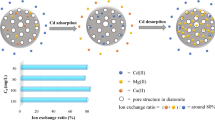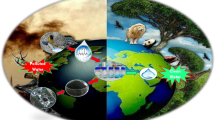Abstract
Reduction in adsorption capacities of adsorbents is limiting of its wider application for water treatment. In this study, we developed a new approach for recycling diatomite to be used adsorbent. The laser scattering particle size analyzer, X-ray diffraction, scanning electron microscopy/energy-dispersive X-ray and Brunauer–Emmett–Teller analysis were used to evaluate the structural characteristics of treated samples. The adsorption efficacy of raw and heated diatomite at 300, 600 and 900 °C for textile dyestuff removal from wastewater was investigated. The characterization results show insignificant changes except some deconstructions were occurred after treatment at 900 °C. The maximum adsorption capacities were obtained at pH 2 and adsorbent dosage of 4 g L−1. The required time to reach the equilibrium was 30 min, and diatomite treated at 600 °C is acted as an excellent adsorbent. The kinetic studies were better described by the pseudo-second-order kinetic model. The isotherms experimental data showed that the adsorption of dye onto raw diatomite, DH300 and DH600 follows the Brunauer–Emmett–Teller isotherm model, but its adsorption onto DH900 conforms well to Freundlich isotherm model. Recycling of diatomite using thermal treatment was useful. At 600 °C which is considered the best regeneration temperature, the adsorbed dye was completely despaired, and around 73% was restored after three regeneration cycles.









Similar content being viewed by others
Abbreviations
- C i :
-
Initial concentration of R-ETL dye (mg L−1)
- C e :
-
Equilibrium concentration of R-ETL dye (mg L−1)
- Q e :
-
Adsorbed quantity of R-ETL dye (mg g−1)
- V :
-
Volume of solution (L)
- W :
-
Amount of adsorbents (g)
- R :
-
Removal efficiency of R-ETL dye (%)
- t :
-
Time (min)
- Q t :
-
Amount of R-ETL dye adsorbed at time t (mg g−1)
- k 1p :
-
Pseudo-first-order kinetic model constant (min−1)
- k 2p :
-
Pseudo-second-order kinetic model constant (g mg−1 h−1)
- k p :
-
Intra-particle diffusion kinetic model constant (g mg−1 min−0.5)
- C t :
-
Concentration at time t (mg L−1)
- D :
-
Intra-particle diffusion coefficient (m2 s−1)
- r :
-
Particle radius assuming spherical geometry (m)
- K F :
-
Freundlich constant (mg g−1) (L g−1)1/n
- 1/n :
-
Freundlich exponent
- K L :
-
Langmuir isotherm constant (L mg−1)
- Q max :
-
Maximum adsorption capacity of R-ETL dye (mg g−1)
- D DR :
-
Dubinin–Radushkevich isotherm constant (mol2 kJ−2)
- T :
-
Temperature (K)
- R :
-
Ideal gas constant (J K−1 mol−1)
- C BET :
-
BET adsorption isotherm constant (L/mg)
- C s :
-
Saturation concentration of R-ETL dye (mg L−1)
- Q s :
-
Monolayer adsorption capacity (mg g−1)
- RMES:
-
Root-mean-squared error
- q expe :
-
Observed amounts of R-ETL dye adsorbed (mg g−1)
- q cale :
-
Predicted amounts of R-ETL dye adsorbed (mg g−1)
- N :
-
Number of experimental measurements
- C u :
-
Coefficients of uniformity
- D10:
-
Intercepts for 10% of the cumulative mass
- D60:
-
Intercepts for 60% of the cumulative mass
References
Abidi N, Errais E, Duplay J et al (2015) Treatment of dye-containing effluent by natural clay. J Clean Prod 86:432–440. https://doi.org/10.1016/j.jclepro.2014.08.043
Akar ST, Özcan AS, Akar T et al (2009) Biosorption of a reactive textile dye from aqueous solutions utilizing an agro-waste. Desalination 249:757–761. https://doi.org/10.1016/j.desal.2008.09.012
Al-Ghouti M, Khraisheh MAM, Ahmad MNM, Allen S (2005) Thermodynamic behaviour and the effect of temperature on the removal of dyes from aqueous solution using modified diatomite: A kinetic study. J Colloid Interface Sci 287:6–13. https://doi.org/10.1016/j.jcis.2005.02.002
Aziz A, Ouali MS, Elandaloussi EH et al (2009) Chemically modified olive stone: a low-cost sorbent for heavy metals and basic dyes removal from aqueous solutions. J Hazard Mater 163:441–447. https://doi.org/10.1016/j.jhazmat.2008.06.117
Belala Z, Jeguirim M, Belhachemi M et al (2011) Biosorption of basic dye from aqueous solutions by Date Stones and Palm-Trees Waste: kinetic, equilibrium and thermodynamic studies. DES 271:80–87. https://doi.org/10.1016/j.desal.2010.12.009
Bhatti HN, Nausheen S (2014) Equilibrium and kinetic modeling for the removal of Turquoise Blue PG dye from aqueous solution by a low-cost agro waste. Desalin Water Treat. https://doi.org/10.1080/19443994.2014.927799
Bisinella F, Nivaldo A, Eduardo C et al (2016) Monolayer–multilayer adsorption phenomenological model: kinetics, equilibrium and thermodynamics. Chem Eng J 284:1328–1341. https://doi.org/10.1016/j.cej.2015.09.085
Chen J, Pan X, Chen J (2013) Regeneration of activated carbon saturated with odors by non-thermal plasma. Chemosphere 92:725–730. https://doi.org/10.1016/j.chemosphere.2013.04.014
de Sales PF, Magriotis ZM, de LS Rossi MA et al (2013) Study of chemical and thermal treatment of kaolinite and its influence on the removal of contaminants from mining effluents. J Environ Manag 128:480–488. https://doi.org/10.1016/j.jenvman.2013.05.035
Devi S, Murugappan A, Rajesh Kannan R (2015) Sorption of reactive blue 19 onto freshwater algae and seaweed. Desalin Water Treat 54:2611–2624. https://doi.org/10.1080/19443994.2014.902333
Djafer A, Kouadri Moustefai S, Iddou A, Si Ali B (2014) Study of bimacid dye removal from aqueous solution: a comparative study between adsorption on pozzolana, bentonite, and biosorption on immobilized anaerobic sulfate-reducer cells. Desalin Water Treat 52:7723–7732. https://doi.org/10.1080/19443994.2013.833866
Djilani C, Zaghdoudi R, Djazi F et al (2015) Adsorption of dyes on activated carbon prepared from apricot stones and commercial activated carbon. J Taiwan Inst Chem Eng 53:112–121. https://doi.org/10.1016/j.jtice.2015.02.025
Dubinin MM, Radushkevich LV (1947) The equation of the characteristic curve of the activated charcoal. Proc Acad Sci USSR Phys Chem Sect 55:331–337
Ebadi A, Soltan Mohammadzadeh JS, Khudiev A (2009) What is the correct form of BET isotherm for modeling liquid phase adsorption? Adsorption 15:65–73. https://doi.org/10.1007/s10450-009-9151-3
Ediz N, Bentli I, Tatar I (2010) Improvement in filtration characteristics of diatomite by calcination. Int J Miner Process 94:129–134. https://doi.org/10.1016/j.minpro.2010.02.004
El Haddad M, Mamouni R, Saffaj N, Lazar S (2012) Removal of a cationic dye—Basic Red 12—from aqueous solution by adsorption onto animal bone meal. J Assoc Arab Univ Basic Appl Sci 12:48–54. https://doi.org/10.1016/j.jaubas.2012.04.003
Foo KY, Hameed BH (2010) Insights into the modeling of adsorption isotherm systems. Chem Eng J 156:2–10. https://doi.org/10.1016/j.cej.2009.09.013
Freundlich HMF (1906) Over the adsorption in solution. J Phys Chem 57:385–471
Gregg SJ, Sing KSW (1982) Adsorption, surface area and porosity, 2nd edn. Academic Press, London
Ho YS, McKay G (1999) Pseudo-second order model for sorption processes. Process Biochem 34:451–465. https://doi.org/10.1016/S0032-9592(98)00112-5
Ibrahim SS, Selim AQ (2012) Heat treatment of natural diatomite. Physicochem Probl Miner Process 48:413–424. https://doi.org/10.5277/ppmp120208
Iddou A, Ouali MS (2008) Waste-activated sludge (WAS) as Cr(III) sorbent biosolid from wastewater effluent. Colloids Surf B Biointerfaces 66:240–245. https://doi.org/10.1016/j.colsurfb.2008.06.018
Iddou A, Hadj Youcef M, Aziz A, Ouali MS (2011) Biosorptive removal of lead (II) ions from aqueous solutions using Cystoseira stricta biomass: study of the surface modification effect. J Saudi Chem Soc 15:83–88. https://doi.org/10.1016/j.jscs.2010.10.007
Johari K, Saman N, Song ST et al (2016) Adsorption enhancement of elemental mercury by various surface modified coconut husk as eco-friendly low-cost adsorbents. Int Biodeterior Biodegrad 109:45–52. https://doi.org/10.1016/j.ibiod.2016.01.004
Kelewou H, Merzouki M, Lhassani A (2014) Biosorption of textile dyes Basic Yellow 2 (BY2) and Basic Green 4 (BG4) by the live yeast Saccharomyces cerevisiae. J Mater Environ Sci 5:633–640
Lagergren S (1898) Zur theorie der sogenannten adsorption geloster stoffe. K. Sven. Vetenskapsakademiens. Handl 24:1–39
Langmuir I (1917) The Constitution and Fundamental Properties of Solids and Liquids. J Am Chem Soc 39:1848–1906. https://doi.org/10.1021/ja02254a006
Mahmoodi NM, Arami M (2008) Modeling and sensitivity analysis of dyes adsorption onto natural adsorbent from colored textile wastewater. J Appl Polym Sci 109:4044–4048. https://doi.org/10.1002/app
Mahmoodi NM, Hayati B, Arami M, Lan C (2011) Adsorption of textile dyes on Pine Cone from colored wastewater: kinetic, equilibrium and thermodynamic studies. Desalination 268:117–125. https://doi.org/10.1016/j.desal.2010.10.007
Mittal A, Mittal J, Malviya A, Gupta VK (2009) Adsorptive removal of hazardous anionic dye “Congo red” from wastewater using waste materials and recovery by desorption. J Colloid Interface Sci 340:16–26. https://doi.org/10.1016/j.jcis.2009.08.019
Naderi M (2014) Surface area: Brunauer–Emmett–Teller (BET). Prog Filtr. https://doi.org/10.1016/b978-0-12-384746-1.00014-8
Ncibi MC, Mahjoub B, Ben Hamissa AM et al (2009) Biosorption of textile metal-complexed dye from aqueous medium using Posidonia oceanica (L.) leaf sheaths: mathematical modelling. Desalination 243:109–121. https://doi.org/10.1016/j.desal.2008.04.018
Rangsriwatananon K, Chaisena A, Thongkasam C (2008) Thermal and acid treatment on natural raw diatomite influencing in synthesis of sodium zeolites. J Porous Mater 15:499–505. https://doi.org/10.1007/s10934-007-9098-2
Reddad Z, Gerente C, Andres Y, Pierre LC (2002) Adsorption of several metal ions onto a low-cost biosorbent: kinetic and equilibrium studies. Environ Sci Technol 36:2067–2073
Sheshdeh RK, Nikou MRK, Badii K et al (2014) Equilibrium and kinetics studies for the adsorption of Basic Red 46 on nickel oxide nanoparticles-modified diatomite in aqueous solutions. J Taiwan Inst Chem Eng 45:1792–1802. https://doi.org/10.1016/j.jtice.2014.02.020
Sing K, Williams R (2004) Physisorption hysteresis loops and the characterization of nanoporous materials. Adsorpt Sci Technol 22:773–782. https://doi.org/10.1260/0263617053499032
Sun Z, Zhang Y, Zheng S et al (2013) Preparation and thermal energy storage properties of paraffin/calcined diatomite composites as form-stable phase change materials. Thermochim Acta 558:16–21. https://doi.org/10.1016/j.tca.2013.02.005
Vimonses V, Lei S, Jin B et al (2009a) Kinetic study and equilibrium isotherm analysis of Congo Red adsorption by clay materials. Chem Eng J 148:354–364. https://doi.org/10.1016/j.cej.2008.09.009
Vimonses V, Lei S, Jin B et al (2009b) Adsorption of congo red by three Australian kaolins. Appl Clay Sci 43:465–472. https://doi.org/10.1016/j.clay.2008.11.008
Wang S, Zhu ZH (2006) Characterisation and environmental application of an Australian natural zeolite for basic dye removal from aqueous solution. J Hazard Mater 136:946–952. https://doi.org/10.1016/j.jhazmat.2006.01.038
Wang Y, Mu Y, Zhao QB, Yu HQ (2006) Isotherms, kinetics and thermodynamics of dye biosorption by anaerobic sludge. Sep Purif Technol 50:1–7. https://doi.org/10.1016/j.seppur.2005.10.012
Wang B, de Godoi FC, Sun Z et al (2015) Synthesis, characterization and activity of an immobilized photocatalyst: natural porous diatomite supported titania nanoparticles. J Colloid Interface Sci 438:204–211. https://doi.org/10.1016/j.jcis.2014.09.064
Weber WJ, Morris JC (1963) Kinetics of Adsorption on Carbon from Solution. J Sanit Eng Div 89:31–60
Ye X, Kang S, Wang H et al (2015) Modified natural diatomite and its enhanced immobilization of lead, copper and cadmium in simulated contaminated soils. J Hazard Mater 289:210–218. https://doi.org/10.1016/j.jhazmat.2015.02.052
Yuan P, Liu D, Fan M et al (2010) Removal of hexavalent chromium [Cr(VI)] from aqueous solutions by the diatomite-supported/unsupported magnetite nanoparticles. J Hazard Mater 173:614–621. https://doi.org/10.1016/j.jhazmat.2009.08.129
Acknowledgements
The authors gratefully acknowledge the financial support provided by the Algerian Ministry of Superior Education and Scientific Research (PNE Program No. 682, Code 16/70682). The authors would like to acknowledge the assistance provided by Mr Kristaps Rubenis, Ms Inga Dušenkova and Ms Valentīna Stepanova, from Rudolfs Cimdins Riga Biomaterials Innovations and Development Center, Institute of General Chemical Engineering, Faculty of Materials Science and Applied Chemistry, Riga Technical University, Latvia, respectively, for SEM micrographs, laser scattering particle size analyzes and BET analyzes. In the end the authors would like to dedicate this work for Prof. Ouali Mohand Said, from Abdelhamid Ibn Badis University, Mostaganem (Algeria), may he rest in peace.
Author information
Authors and Affiliations
Corresponding author
Additional information
Editorial responsibility: M. Abbaspour.
Rights and permissions
About this article
Cite this article
Aguedal, H., Iddou, A., Aziz, A. et al. Effect of thermal regeneration of diatomite adsorbent on its efficacy for removal of dye from water. Int. J. Environ. Sci. Technol. 16, 113–124 (2019). https://doi.org/10.1007/s13762-018-1647-5
Received:
Revised:
Accepted:
Published:
Issue Date:
DOI: https://doi.org/10.1007/s13762-018-1647-5




